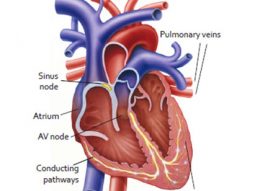Extensive research has identified factors that increase a person’s risk for coronary heart disease in general and heart attack in particular.
The more risk factors you have, and the greater the degree of each risk factor, the higher your chance of developing coronary heart disease – a common term for the build-up of plaque in the heart’s arteries that could lead to heart attack.
Risk factors fall into three broad categories:
- Major risk factors: they significantly increase the risk of heart and blood vessel (cardiovascular) disease.
- Modifiable risk factors: some major risk factors can be modified, treated or controlled through medications or lifestyle change.
- Contributing risk factors: these factors are associated with increased risk of cardiovascular disease, but their significance and prevalence have not yet been determined.
You should focus on heart disease prevention early in life. To start, assess your risk factors and work to keep them low. The sooner you identify and manage your risk factors, the better your chances of leading a heart-healthy life.
MAJOR RISK FACTORS THAT CAN’T BE CHANGED
You may be born with certain risk factors that cannot be changed. The more of these risk factors you have, the greater your chance of developing coronary heart disease. Since you can’t do anything about these risk factors, it’s even more important that you manage the risk factors that can be changed.
Increasing Age
The majority of people who die of coronary heart disease are 65 or older. While heart attacks can strike people of both sexes in old age, women are at greater risk of dying (within a few weeks).
Male gender
Men have a greater risk of heart attack than women do, and men have attacks earlier in life.
Even after women reach the age of menopause, when women’s death rate from heart disease increases, women’s risk for heart attack is less than that for men.

Heredity (including race)
Children of parents with heart disease are more likely to develop heart disease themselves.
African-Americans and Asian-Americans have more severe high blood pressure than Caucasians, and a higher risk of heart disease. This is partly due to higher rates of obesity and diabetes.
Most people with a significant family history of heart disease have one or more other risk factors. Just as you can’t control your age, sex and race, you can’t control your family history.
So, it’s even more important to treat and control any other modifiable risk factors you have.
MAJOR RISK FACTORS YOU CAN MODIFY, TREAT OR CONTROL
Tobacco smoke
The risk that smokers will develop coronary heart disease is much higher than that for non-smokers.
Cigarette smoking is a powerful independent risk factor for sudden cardiac death in patients with coronary heart disease. Cigarette smoking also interacts with other risk factors to greatly increase the risk for coronary heart disease. Exposure to other people’s smoke increases the risk of heart disease even for non-smokers.
High blood cholesterol
As your blood cholesterol rises, so does your risk of coronary heart disease. When other risk factors (such as high blood pressure and tobacco smoke) are also present, this risk increases even more. A person’s cholesterol level is also affected by age, sex, heredity and diet.
- Low-density-lipoprotein (LDL) cholesterol = “bad” cholesterol: A low LDL cholesterol level is considered good for your heart health. Lifestyle factors, such as a diet high in saturated and trans fats, can raise LDL cholesterol.
- High-density-lipoprotein (HDL) cholesterol = “good” cholesterol: With HDL cholesterol, higher levels are typically better. Low HDL cholesterol puts you at higher risk for heart disease. Genetic factors, Type 2 diabetes, smoking, being overweight and being sedentary can all result in lower HDL cholesterol.

- Triglycerides:Triglycerides are the most common type of fat in the body. Normal triglyceride levels vary by age and sex. A high triglyceride level combined with low HDL cholesterol or high LDL cholesterol is associated with atherosclerosis, which is the build-up of fatty deposits inside artery walls that increases the risk for heart attack and stroke.
High blood pressure
High blood pressure increases the heart’s workload, causing the heart muscle to thicken and become stiffer. This stiffening of the heart muscle is not normal and causes the heart to function abnormally. It also increases your risk of stroke, heart attack, kidney failure and congestive heart failure.
When high blood pressure is present alongside obesity, smoking, high blood cholesterol levels or diabetes, the risk of heart attack or stroke increases even more.
Physical inactivity
An inactive lifestyle is a risk factor for coronary heart disease. Regular, moderate to vigorous physical activity helps reduce the risk of cardiovascular disease. Physical activity can help control blood cholesterol, diabetes and obesity. It can also help to lower blood pressure in some people.
Obesity and being overweight
People who have excess body fat – especially if a lot of it is at the waist – are more likely to develop heart disease and stroke, even if those same people have no other risk factors.
Overweight and obese adults with risk factors for cardiovascular disease such as high blood pressure, high cholesterol or high blood sugar can make lifestyle changes to lose weight and produce significant reductions in risk factors such as triglycerides, blood glucose, HbA1c and the risk of developing Type 2 diabetes.
Many people may have difficulty losing weight. But for those above a healthy weight, a sustained weight loss of 3 to 5 per cent of your body weight may lead to significant reductions in some risk factors. Greater sustained weight losses can improve blood pressure, cholesterol and blood glucose.
Diabetes
Diabetes seriously increases your risk of developing cardiovascular disease.
Even when glucose levels are under control, diabetes increases the risk of heart disease and stroke. The risks are even greater if blood sugar is not well-controlled.
If you have diabetes, be sure to work with your doctor to manage it, and control any other risk factors that you can. To help manage blood sugar, people with diabetes who are obese or overweight should make lifestyle changes, such as eating better or getting regular physical activity.
OTHER FACTORS THAT CONTRIBUTE TO HEART DISEASE RISK
Stress
Individual response to stress may be a contributing factor for heart attacks.
Scientists have noted a relationship between coronary heart disease risk and stress in a person’s life, along with their health behaviours and socioeconomic status. These factors may affect established risk factors.
For example, people under stress may overeat, start smoking or smoke more than they otherwise would.

Alcohol
Drinking too much alcohol can raise blood pressure, and increase your risk for cardiomyopathy, stroke, cancer and other diseases. It can also contribute to high triglycerides, and produce irregular heartbeats. Additionally, excessive alcohol consumption contributes to obesity, alcoholism, suicide and accidents.
All that said, there is a protective benefit to moderate alcohol consumption.
If you drink, limit your alcohol consumption to no more than two drinks per day for men and no more than one drink per day for women.
Diet and nutrition
A healthy diet is one of the best weapons you have to fight cardiovascular disease. What you eat (and how much) can affect other controllable risk factors, such as cholesterol, blood pressure, diabetes and being overweight.
Choose nutrient-rich foods, which have vitamins, minerals, fibre and other nutrients, but are lower in calories than nutrient-poor foods. Choose a diet that emphasises vegetables, fruits and whole grains. A heart-healthy diet also includes low-fat dairy products, poultry, fish, legumes, nuts and non-tropical vegetable oils. Be sure to limit your intake of sweets, sugar-sweetened beverages and red meats.
To maintain a healthy weight, coordinate your diet with your physical activity level so you’re using up as many calories as you take in.
PREVENTING HEART ATTACKS

Too young to worry about heart attack?
A heart attack can occur at any age. You’re never too young to start heart-healthy living. If you’re over 40, or if you have multiple risk factors, work closely with your doctor to address your risk of developing cardiovascular disease.
Heart attack prevention is critical. It should begin early in life. Start with an assessment of your risk factors. Then develop a plan you can follow to maintain a low risk for heart attack.
For many people, their first heart attack is disabling or even fatal. Do everything you can to lower your risk.
Learn heart-health basics
Reducing your risk starts with smart choices:
- If you smoke, stop.
- Work with your doctor to manage your risk factors. These might include high blood pressure, high cholesteroland diabetes.
- An active lifestyle and good nutrition have also been shown to be helpful in preventing heart attack.
- Follow seven simple stepstoward healthier living (read “My Life Check – The 7 Steps to Live Better”
Perform Coronary Artery Disease (CAD) Screening at FV Hospital
CAD screening is recommended for:
- Patients between 30 and 45-y old with at least 2 risk factors
- Patients more than 45-y old with one risk factor
- Women after their menopause
The FV Hospital CAD screening programme includes:
- MDCT (Multi-Detector Computerized Tomography) Scanner with Calcium Scoring and Coronary CT Angiography
- ECG
- Echocardiography
- Consultation with cardiologist
The MDCT procedure can be performed in a short time, delivers a high accuracy of over 90% in detecting coronary artery disease. Patient is not required to stay in hospital after the procedure.

 Vi
Vi 












